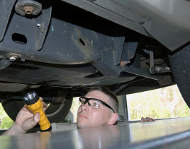3/17/2011
North Carolina Considers Dumping Vehicle Safety InspectionsLegislative report finds no measurable benefit for safety and emissions inspections.

Fourteen state senators want to do away with safety inspections for vehicles in the North Carolina. Led by state Senator Stan Bingham (R-Denton), the group introduced Senate Bill 123 last month in response to a 2008 legislative report suggesting the benefit of imposing the $165 million annual burden on motorists has yielded no measurable safety benefit.
Each year, the state's 6.1 million vehicles must be taken to a private station for a $13.60 safety inspection. Vehicles registered in half of the state's counties must also take a $30 emissions test. The state only keeps 85 cents out of the safety inspection fee, with the remainder kept by the inspector who also earns significant revenue by repairing whatever faults he discovers.
The legislative auditors surveyed available data from around the country and concluded that there is no reliable evidence to show that safety inspections reduce accidents. They looked in particular at states that had such programs and later dropped them. Nebraska's three-year average number of crashes with inspections in place was 1759. After inspections were dumped in 1982, the three-year average dropped to 1486. In North Carolina, vehicle defects only accounted for the cause of one percent of accidents.
The reliability of the tests is also open to question. Pennsylvania officials took a vehicle with thirteen defects to twenty inspection stations. Most found only seven problems, while some stations invented non-existent defects. In North Carolina, 97.7 percent of tested vehicles passed. Cars between ten and thirty years old failed more often, but they comprised a small portion of the state's vehicles. The reasons cited for failure most often were defective tires, burned out stop lights, inadequate windshield wipers. A total of 30,238 people were failed because of a burned out license plate light. The auditors found this result did not justify the hassles involved.
"In addition to the price of the inspection, motorists also incur other costs associated with getting an inspection," the report stated. "Travel time, wait time, and time away from work or other activities are costs incurred by individuals who must get a vehicle inspection. The Program Evaluation Division estimates the indirect costs associated with getting an emissions inspection are approximately $21 million."
Although the air quality in North Carolina has been improving, the auditors had no way to link the improvement to the emissions testing program. Because federal rules handed down by the Environmental Protection Agency (EPA) govern the operation of the emissions inspection program, state lawmakers are not entirely free to drop the program without first obtaining EPA approval of their plans. The legislative auditors recommended that at least newer vehicles be exempted from the annual hassle.
"Program Evaluation Division analysis shows newer vehicles are less likely to fail emissions inspections," the report stated. "Analysis also shows exempting vehicles from the three newest model years does not affect the overall failure rate for the state. By exempting vehicles from the three newest model years, the state would relieve the annual emissions requirement for 19 percent of vehicles."
A copy of the legislative study is available in a 1mb PDF file at the source link below.


